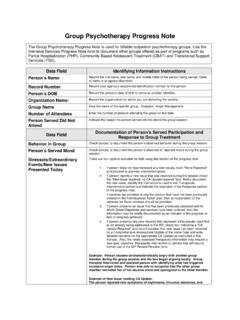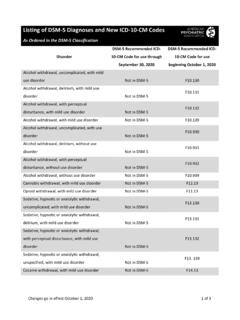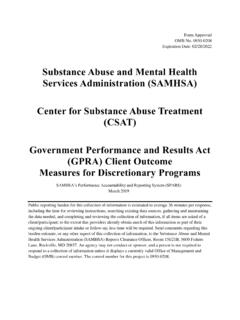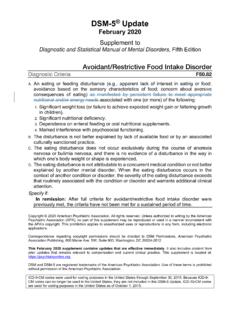Transcription of Discharge Summary/Transition Plan - abhmass.org
1 Discharge Summary/Transition plan The Discharge Summary/Transition plan is designed as a two-page form, encapsulating the course of treatment, outcomes, and reasons for transition or Discharge . This plan should be initiated as early in the treatment as possible to ensure steps are taken to provide continuity of care. Data Field Identifying Information Instructions Person Name Record the first name, last name, and middle initial of the person. Order of name is at agency discretion. Record # Record your agency s established identification number for the person. Admission Date Document the date the person was admitted. Organization/program Name Record the organization/program for whom you are delivering the service. Document person s date of birth.
2 Gender Indicate person s gender by checking the appropriate box. If checking Transgender box, also complete box of current gender designation for insurance purposes. transition From/To Check if person is being transitioned internally. Indicate the unit/program from which person is being transitioned and to which unit/program person will be transitioned. Discharge Check if person is being discharged from the agency/program. Last Contact Document the last date of contact with the person. transition / Discharge Date Document the date that the person is being transitioned or discharged. Person s location and contact information post Discharge / transition Indicate person s physical location and contact information, including the specific address and telephone number if known, immediately after Discharge .
3 If unknown, check box. This information may be utilized for post- Discharge / transition contacts including the gathering of outcomes information. If the person was discharged to a shelter, document all efforts made to prevent this placement. Data Field summary of Treatment Strengths, Needs, Abilities and Preferences ( ) and Status at Last Contact Document the person s strengths, abilities and preferences ( ). Document the status of the person at last contact and include legal status and criminal activity, if applicable, at the time of Discharge . summary of Services/Treatment Provided Provide a narrative summary of the person s presenting issues, services and treatment that were provided. Consider vocational, educational, financial, legal, medical, behavioral and risk status.
4 Outcomes Include qualitative and quantitative information regarding the person s progress/gains achieved, strengths, abilities and preferences. Indicate names of any standardized measures used and a summary of the outcome information including vocational/educational/financial status or achievements. Health and Safety Concerns (include risk of overdose) Document health and safety concerns; include behavioral, medical and/or substance use issues. Include risk of overdose. Check if Not Applicable. Describe the person s current vocational, educational, and financial status This section is mandatory for BSAS licensed services. Describe the person s current legal problems This section is mandatory for BSAS licensed services. Describe supports and services available to the person after Discharge , provided by the licensee or others This section is mandatory for BSAS licensed services.
5 Goal Status Check the numbers of the goals addressed in treatment based on Individualized Action plan . For each goal, identify with a keyword and indicate the status by checking whether that goal at the time of Discharge has been met, partially met, not met, or discontinued. Insert any additional comments in the spaces provided. Overall Progress in Treatment Document the person's overall progress in treatment. Data Field Diagnosis General Instructions: Diagnosis Spaces are provided to capture the information gathered at intake and time of transition / Discharge . This section is used to record all current diagnoses that will provide the documented support for the medical necessity of services that will be provided for the person.
6 diagnoses can be recorded in either ICD- 10 cm codes and narrative, or DSM codes and narrative. Check the applicable box at the top of the Diagnosis section to indicate if you are using ICD or DSM codes. icd cm Codes: Check if using ICD-9 or ICD-10 codes. List codes in appropriate order using ICD-9 or ICD-10 coding conventions. Next to each code, complete a narrative description of the code from the ICD-9 or ICD- 10 cm code book. Place a check next to the diagnosis that is the primary diagnosis for this treatment episode. DSM Diagnostic Codes: Check if using DSM-IV or DSM 5 codes. List codes using DSM coding conventions. Next to each code, complete a narrative description from the DSM code book. Place a check next to the diagnosis that is the primary diagnosis for this treatment episode.
7 Check Primary/ Billing Diagnosis Check the primary/billing diagnosis. Code Indicate the ICD or DSM numerical or alphanumerical code. Narrative Description List the narrative description of the code in either DSM or ICD terminology. Data Field Reason for transition / Discharge Reasons Check to indicate reason(s) for transition / Discharge . If involuntary/ administratively discharged, summary of disciplinary action taken If not applicable, check box provided. Include reasons, as well as the decision of the grievance hearing, or if the client elected not to be heard, a clear statement of the circumstances of termination, suspension, or any lesser sanction imposed. Check whether or not the person was notified of the appeal process. Data Field Person s Response Person s Response to Treatment and transition / Discharge Summarize person s response to this treatment episode and how he/she feels regarding the transition / Discharge .
8 Data Field Medications Medications as Reported by Person at time of transition / Discharge List medication name, dose, plans for change (including rate of Detox). Record the name of the prescriber as reported by the person at the time of transition / Discharge . Data Field Continuity of Care/Referral Instructions: Referred To List all internal and external services/programs to which the person is being referred at the point of transition / Discharge . Specify agency/program name, location, and any other contact information the person or parent/guardian will need to ensure continuity of care For Specify the types of services or programs, or reason why person is being referred for each particular listing. Date(s)/Time(s) of Appointments if known Indicate any specific dates and/or times of appointments that have been set up for the person.
9 Aftercare plan and Options Document information on symptoms the person should watch for, options available if the symptoms reoccur, additional services that may be needed or preferred by the person and follow-up plans. Data Field Staff Signatures Instructions Person Signature If appropriate, legibly record signature of the person or his/her parent/guardian. Date Date of this signature. Parent/Guardian Signature (if appropriate) If appropriate, legible record signature of the person's parent/guardian. Clinician/Provider Print Name/Credentials Legibly record name and credentials, according to agency policy, of the clinician/primary provider of services, coordinator of services, or the author of the plan . Date Date of this signature.
10 Supervisor s Signature (if needed) Legible signature and credentials of supervisor. Example: Jerry Smith, LMHC Date Date of this signature. Supervisor Print Name/Credential (if needed) Legible supervisor name and credentials, according to agency policy. Date Date of this signature. Psychiatrist/MD/DO Signature (If needed) Record signature here. Date Date of this signature. Data Field Client Copy Copy of transition / Discharge plan Indicate if a copy of the plan has been given to the person, mailed to the person, or did not receive a copy. If person did not receive a copy, provide explanation.











